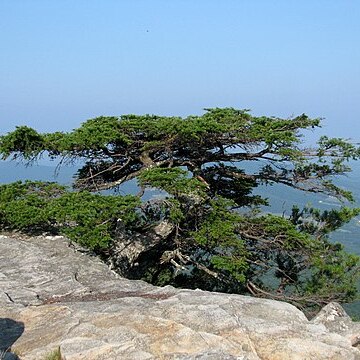An evergreen pine tree. It grows 20 m high. The tree is broadly cone shaped. The bark is red-brown and furrowed. Ridges develop with age. The leaves are narrow and 2 cm long. They are dark green above and have 2 white bands underneath. The male and female flowers are in separate clusters. They are both brown and the male ones are below the shoot while female ones are at the tip. The fruit is a pale brown hanging cone. It is 2.5 cm long.
Similar to no. 1 [Tsuga canadensis (L.) Carrière]; lvs entire, averaging slightly larger, more diversely oriented, so that the sprays are not so flat; cones 25–35 mm, the scales widely spreading at maturity, oblong-ovate, the exposed portion of the middle ones at least as long as wide. Ravines and rocky hillsides in the Blue Ridge Prov., rarely on the Piedmont; sw. Va. to n. Ga.


